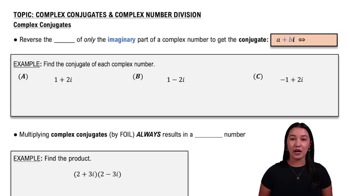Here are the essential concepts you must grasp in order to answer the question correctly.
Rationalizing the Denominator
Rationalizing the denominator involves eliminating any irrational numbers from the denominator of a fraction. This is typically achieved by multiplying both the numerator and the denominator by a suitable expression that will result in a rational number in the denominator. For example, if the denominator is a sum of square roots, one can multiply by the conjugate of that expression.
Recommended video:
Rationalizing Denominators
Conjugates
The conjugate of a binomial expression is formed by changing the sign between the two terms. For instance, the conjugate of (a + b) is (a - b). When multiplying a binomial by its conjugate, the result is a difference of squares, which simplifies to a rational number. This technique is essential in rationalizing denominators that contain sums or differences of square roots.
Recommended video:
Properties of Square Roots
Understanding the properties of square roots is crucial for simplifying expressions involving them. The key property states that √a * √b = √(a*b). This property allows for the combination of square roots and is often used when rationalizing denominators. Additionally, knowing that √(a + b) cannot be simplified directly into separate square roots is important for correctly manipulating expressions.
Recommended video:
Imaginary Roots with the Square Root Property
 Verified step by step guidance
Verified step by step guidance Verified Solution
Verified Solution



 2:9m
2:9m